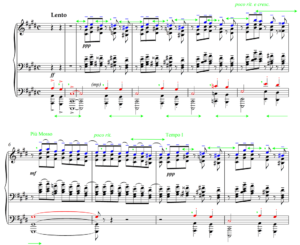The Art of Piano Transcription As Critical Commentary
Art of Piano Transcription
Piano transcription is a type of music criticism that involves the extraction of information from a musical piece. It involves the analysis of another artist’s composition in order to elucidate its underlying qualities. A great deal of work goes into piano transcription, which has a long history.
Franz Liszt ushered in a new era of virtuoso piano transcriptions. His transcriptions of Schubert’s songs helped popularize his works. He preserved the emotional depth of the original works while retaining their technical aspects. As a result, his transcriptions are challenging for pianists and vocalists alike. In addition to a rich sense of colour and structure, Liszt’s transcriptions also require a performer to convey the meaning of a song’s lyrics and ornamentation.

Piano transcription is a two-stage process. First, the individual note waveforms are recorded. Next, they are verified. The note verification stage aims to eliminate false positive notes and improve transcription precision. This is achieved by estimating the onset time, pitch, and offset of each candidate note. If the difference between the reconstruction and the original spectrogram is small, the note is considered a valid candidate.
The Art of Piano Transcription As Critical Commentary
Piano transcription is widely used in music visualization and music information retrieval. It has many applications in music education. For example, it can produce a score or a piano roll. One can also use an automatic music transcription system to transcribe a musical composition.
Piano transcriptions have evolved as a critical commentary. Great composers have fashioned piano transcriptions of pieces from every genre. They are important for amateur players and performers, who often want repertoire they can enjoy at home. Often, they also provide a vehicle for critical commentary on other artists’ ideas.
Franz Liszt’s transcriptions have been the subject of significant research during the last decade. These studies have led to supplementary volumes edited by Imre Mezo and Adrienne Kaczmarczyk. The volumes contain critical commentary on each composition and include translations. They also include earlier versions of some works. These include unfinished and early versions of some solo piano works, such as Berloz’s Harold in Italy, and early versions of the Fifth and Sixth Symphonies of Beethoven.
Among the most noteworthy supplementary volumes are Various Songs of the Century, which contains translations, pronunciation guidance, and a critical commentary. This volume also includes songs by Chabrier, Reber, and Saint-Saens.
Another important supplementary volume is MIDI-Aligned Piano Sounds (MAPS), which has a large database of piano transcriptions. It comprises 30 pieces of music, 60 hours of audio, and annotated text files. Moreover, the volume contains chords, isolated notes, and aligned MIDI files. During the editing process, the NLE editors thoroughly consider Liszt’s philological findings, and they are fully integrated into the preparation of the Supplement volumes.
Unlike other forms of music criticism, piano transcription has a long history. In fact, it is a competitive field every year. Each publisher strives to produce the most complete and accurate edition of a musical work. By doing so, it provides a valuable resource for pianists and performers.